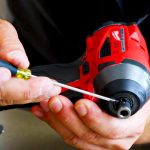Table of Contents
If you are a craftsman or DIY enthusiast, then you should already be quite familiar with tapcons. For anchors, expansion plugs, or lag shields, you can easily replace them with tapcons. The best way to install tapcons is by using a hammer drill, which is almost always available inside a handyman’s toolbox. But, if you don’t have it with you, will you still be able to install tapcons?
Of course, you can! If you can invest enough time and effort, you won’t need a hammer drill to install tapcons. So here, we will discuss how to do that and discuss some essential tips to make the task easier and safe.
Hammer Drill Alternative For Installing Tapcons
When installing tapcons, you will first need to drill some pilot holes. This is where a hammer drill comes into play. However, if you have the right bit of decent quality, and a masonry drill or a standard twist drill, you can use them too.
There is another option for you if you don’t want to invest in a brand-new hammer drill. You can use hammer drill adapters with your regular drill, which makes it function just like a hammer drill. However, before buying such adapters, make sure they are compatible with your drill.
Both choices are good hammer drill alternatives for installing tapcons. However, in this article, we will focus on a quick fix. So, let’s take a closer look at how to install tapcons with a masonry drill bit.
How To Install Tapcons With A Masonry Drill:
You can effortlessly install tapcons using masonry drill bits if you follow this step-by-step guide. Here is an outline of what you need to do.
Step 1: Drill A Pilot Hole
Measure your tapcon screw by calculating its diameter and length. Grab your masonry drill a bit with a carbide tip and drill a hole matching the tapcon’s diameter. Remember to make the hole at least 1.27 cm or 0.5 inches deeper than the tapcon’s length.
While you’re on it, make sure to not let the motor or bit become overheated. This will ensure the longevity of your drill.
Step 2: Clean The Hole
After creating the hole, you’ll find lots of dust accumulated inside the hole and on the floor. Clean up the hole and the area with the help of a wire brush or a mini vacuum cleaner. Check once again if the hole is deep enough for a tapcon screw.
Step 3: Insert The Tapcon Screw
You can now insert the tapcon into the hole. Make sure it fits well and doesn’t leave too much empty space around. Using a rotation drill, slowly and carefully drive the screw in. Try not to put too much pressure.
Step 4: Tighten It Up
Too much torque and rotation of the tapcon may result in it losing its holding value. Consequently, it won’t firmly stay in its place. To preserve the screw’s holding value in the hole, use your hand for the final few rotations and tighten up the tapcon. Check to see if it is attached properly and that it does not budge or wobble.
Essential Tips For Using A Masonry Drill
Tapcons are most commonly used in concrete and wood. These surfaces are often extremely sturdy, resilient, and incredibly durable. Therefore, using anything else other than a hammer drill to install tapcons might seem difficult sometimes.
However, the following tips will help to make the job easier.
- Do not use anything other than a hammer drill if you are working with aged concrete since they have a much higher density.
- Make sure the drill bit is carbide-tipped. This is important because carbide-tipped bits are very strong, and they can be reused by resharpening them.
- Take your time and do not rush. Otherwise, you may end up with a damaged drill or surface.
- Keep a few high-quality bits of different sizes nearby. You will probably have to start by drilling a small hole and then making it larger with other bits.
- Since your standard drill is not designed for this type of task, it might get overheated. Your bit’s tip can overheat too. The best way to cool the bit down is to use water. By cooling your bits and drilling down, you’ll increase their overall lifespan.
- Be gentle. Expect the whole process to take more time than it would with a hammer drill. So, have patience and focus on efficiency. Keep switching your bits until you drill the required-sized hole.
- To mimic the hammering action, you can use your hands to move the drill to and fro. However, be very careful with it and put minimum pressure.
- Don’t max out on the drill’s speed. This will unnecessarily burn your motor out. Start with the lowest speed and slowly move your way up as needed.
- Take the drill bit out and remove any dust that may have accumulated. This will allow the bit to work more effectively and efficiently.
- If any stone or obstacle blocks your way, use a hammer and nail to break it manually.
Final Thoughts
So, we can conclude that when it comes to installing tapcons, a hammer drill is not mandatory. A standard drill and some decent-quality bits will do the job just fine.
However, we do not recommend using this alternative as a permanent solution. This process requires time, effort, good hand-eye coordination, control, and massive amounts of patience. Even after that, you still carry the risk of breaking your drill or the surface.
Therefore, if you find yourself regularly working with tapcons and concrete surfaces, invest in a high-quality hammer drill. Thank you for reading!










Leave a Comment